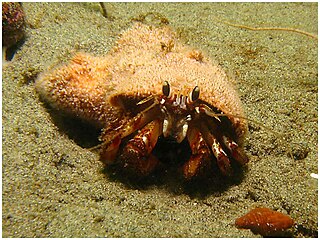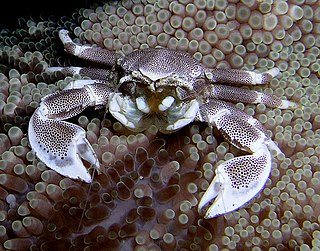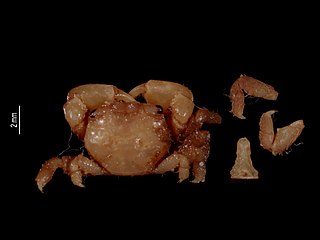
The Decapoda or decapods are an order of crustaceans within the class Malacostraca, including many familiar groups, including crabs, lobsters, crayfish, shrimp, and prawns. Most decapods are scavengers. The order is estimated to contain nearly 15,000 species in around 2,700 genera, with around 3,300 fossil species. Nearly half of these species are crabs, with the shrimp and Anomura including hermit crabs, porcelain crabs, squat lobsters making up the bulk of the remainder. The earliest fossils of the group date to the Devonian.

King crabs are a taxon of decapod crustaceans that are chiefly found in cold seas. Because of their large size and the taste of their meat, many species are widely caught and sold as food with the most common being the red king crab.

Carcinisation is a form of convergent evolution in which non-crab crustaceans evolve a crab-like body plan. The term was introduced into evolutionary biology by L. A. Borradaile, who described it as "the many attempts of Nature to evolve a crab".

Porcelain crabs are decapod crustaceans in the widespread family Porcellanidae, which superficially resemble true crabs. They have flattened bodies as an adaptation for living in rock crevices. They are delicate, readily losing limbs when attacked, and use their large claws for maintaining territories. They first appeared in the Tithonian age of the Late Jurassic epoch, 145–152 million years ago.

The Ocypodoidea, or ocypoid crabs, are a superfamily of crabs, named after the genus Ocypode. It contains over 300 extant species in these eight families:

The Diogenidae are a family of hermit crabs, sometimes known as "left-handed hermit crabs" because in contrast to most other hermit crabs, its left chela (claw) is enlarged instead of the right. It comprises 429 extant species, and a further 46 extinct species, making it the second-largest family of marine hermit crabs, after the Paguridae.

Parthenopidae is a family of crabs, placed in its own superfamily, Parthenopoidea. It comprises nearly 40 genera, divided into two subfamilies, with three genera incertae sedis:

Pagurus is a genus of hermit crabs in the family Paguridae. Like other hermit crabs, their abdomen is not calcified and they use snail shells as protection. These marine decapod crustaceans are omnivorous, but mostly prey on small animals and scavenge carrion. Trigonocheirus and Pagurixus used to be considered subgenera of Pagurus, but the former is nowadays included in Orthopagurus, while the latter has been separated as a distinct genus.

Dromiidae is a family of crabs, often referred to as sponge crabs. They are small or medium-sized crabs which get their name from the ability to shape a living sponge into a portable shelter for themselves. A sponge crab cuts out a fragment from a sponge and trims it to its own shape using its claws. The last two pairs of legs are shorter than other legs and bend upward over the crab's carapace, to hold the sponge in place. The sponge grows along with the crab, providing a consistent shelter.

Hippoidea is a superfamily of decapod crustaceans known as sand crabs or mole crabs.

Johngarthia is a genus of crabs in the land crab family Gecarcinidae, formerly included in the genus Gecarcinus, and containing six species. The genus bears the name of John S. Garth, a 20th century naturalist who specialized in crabs and other arthropods.

Pilumnoidea is a superfamily of crabs, whose members were previously included in the Xanthoidea. The three families are unified by the free articulation of all the segments of the male crab's abdomen and by the form of the gonopods. The earliest fossils assigned to this group are of Eocene age.

Inachidae is a family of crabs, containing 39 genera:
Osachila is a genus of crabs in the family Aethridae, containing three fossil species, and the following extant species:

The Galatheoidea are a superfamily of decapod crustaceans comprising the porcelain crabs and some squat lobsters. Squat lobsters within the three families of the superfamily Chirostyloidea are not closely related to the squat lobsters within the Galatheoidea. The fossil record of the superfamily extends back to the Middle Jurassic genus Palaeomunidopsis.

Paraxanthias is a genus of crabs in the family Xanthidae, containing one exclusively fossil species and the following extant species:

Hippa is a genus of decapod crustaceans in the family Hippidae, containing the following species:

The Camptandriidae are a family of crabs, with 38 species in 21 genera:

Pachycheles is a genus of porcelain crabs in the family Porcellanidae. There are more than 40 described species in Pachycheles.

Heptacarpus is a genus of shrimps in the family Thoridae. There are more than 30 described species in the genus Heptacarpus.


















